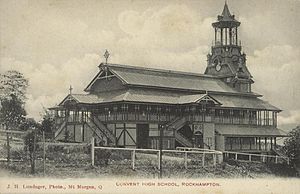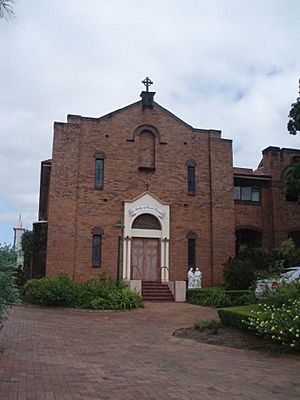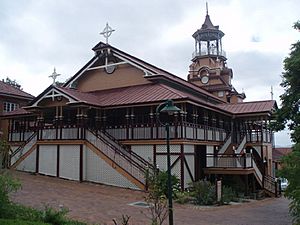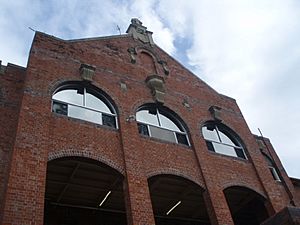The Range Convent and High School facts for kids
Quick facts for kids The Range Convent and High School |
|
|---|---|
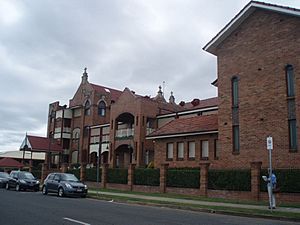
The Range Convent and High School, view from Agnes Street, 2009
|
|
| Location | 263 Agnes Street, The Range, Rockhampton, Rockhampton Region, Queensland, Australia |
| Design period | 1870s - 1890s (late 19th century) |
| Built | c.1880s - 1930s |
| Official name: The Range Convent and High School, Our Lady of Good Counsel Convent and School, The Catholic College Residential | |
| Type | State heritage (landscape, built) |
| Designated | 21 October 1992 |
| Reference no. | 600779 |
| Significant period | 1890s-1910s (historical) 1900s-1910s (fabric middle hall) 1880s, 1930s (fabric convent) 1920s (fa |
| Significant components | Tower, convent/nunnery, garden/grounds, swimming pool, dormitory, classroom/classroom block/teaching area |
| Lua error in Module:Location_map at line 420: attempt to index field 'wikibase' (a nil value). | |
The Range Convent and High School is a historic school building in Rockhampton, Queensland, Australia. It is located on Agnes Street in The Range area. This special place was built between the 1880s and 1930s. It is also known as Our Lady of Good Counsel Convent and School. Today, it is part of The Catholic College Residential. This site is so important that it was added to the Queensland Heritage Register in 1992.
Contents
A Look at the School's Past
The first Catholic school in Rockhampton started around 1864. In 1873, a group of nuns called the Sisters of Mercy arrived. They took over the primary school and also opened a high school.
In 1895, the school and the nuns' home (convent) moved to their current spot. This new location was on the Athelstane Range, a bit west of the city. The Sisters of Mercy had already set up six of their homes in Queensland, and Rockhampton became a key base for them in Central and North Queensland.
The new school was first called the School of Our Lady of Good Counsel. But because it was on Athelstane Range, everyone just called it The Range Convent and High School. When the local Bishop, Rev John Cani, passed away in 1898, he left the school buildings and land to the Sisters of Mercy.
Growing the School Buildings
Over time, the school grew with new buildings. Around 1900, an upper floor was added to the convent. A timber chapel was also built for religious services.
A new school building, called Middle Hall, was planned in 1905. Bishop James Duhig was very involved in its design. He believed in good education for girls. Middle Hall was finished in 1908. It was a two-storey building with a cool tower.
Inside Middle Hall
The ground floor of Middle Hall had ten music rooms, a library, and rooms for art, photography, and cooking. The first floor was a large hall used for classrooms. The tower above the hall had two levels and an open balcony. This open space was meant to be an observatory! It even had metal panels with stars and moons on them.
The building was designed to be very healthy and safe. It had wide verandahs on three sides and good ventilation. Bishop Duhig thought it was one of the best school buildings in Queensland.
Outdoor Spaces and More Buildings
After Middle Hall was built, the school grounds got a makeover. They added a tennis court and pathways around a grotto (a small cave-like structure) that was built in 1906. This area became a peaceful courtyard, a main spot for outdoor activities.
In 1920, the school needed more space for students who lived there (boarders). A large three-storey brick building called Genazzano was built. It faced Agnes Street and could house 80 boarders. It had dining halls, recreation areas, and modern facilities.
In 1926, a swimming pool was built. It's thought to be the first school pool in Rockhampton! It had ten changing sheds.
By 1930, the nuns also needed more living space. A new three-storey brick building, the Convent Dormitory, was built for them. It had community rooms and bedrooms.
Later, in 1949, a science block was added. This building had labs for domestic science, physics, and chemistry. It was expanded in 1951 as more students stayed on to finish high school.
A New Chapel and Changes
The original timber chapel was used until 1956. Then, a new brick chapel was built. The old timber chapel was moved and used for boarding, but it was later taken off the site. The new brick chapel had beautiful stained glass windows from Ireland. The statue of Our Lady of Good Counsel, who the school was named after, was placed near its entrance.
Many more buildings were added in the 1960s and 1970s, including new classrooms and another boarding house.
In 1983, Range College became a junior high school. A new senior Catholic college, Emmaus, was opened. By 1990, Range College was sold. It closed when The Cathedral College opened nearby. Today, the boarding houses, Genazzano and Coolock, are used by students from The Cathedral College. The Sisters of Mercy still use the convent and chapel.
What the School Looks Like Today
The Range College is on Athelstane Range, looking towards Rockhampton city. It has many important buildings and garden areas. These include Middle Hall, the brick buildings along Agnes Street (like the convent, student dorms, and nuns' dorms), a peaceful courtyard called the cloister, and the swimming pool.
The Convent
The Convent is a two-storey building made of timber and brick. It started as the Bishop's house and has been added to over the years. You can still see parts of the original house inside.
The Chapel
The Chapel is a rectangular brick building at the south end of the convent. It has a main entrance on the west side. Inside, you'll find beautiful timber work, four stained glass windows near the altar, and important statues.
Middle Hall
Middle Hall is a two-storey timber building with a tower. It's right in the middle of the school grounds. It has a gabled roof and verandahs on three sides. The tower is very special, with timber decorations and a spired roof. The first floor, a large hall, has a pressed metal ceiling.
Genazzano
Genazzano is a three-storey brick building on Agnes Street. It has a corrugated iron roof and brick sections at the ends. It's surrounded by three storeys of brick arched verandahs.
The Convent Dormitory
The convent dormitory is another three-storey brick building, similar to Genazzano. It's north of the convent and also has three storeys of brick arched verandahs. The ground floor has lounges, and the upper floors have single bedrooms that open onto the wide verandahs.
The Cloister
Middle Hall, the convent, the dormitory, and the chapel create a courtyard called the cloister. It has a large old tree, other plants, and a stone grotto covered in vines with a statue of Our Lady of Lourdes. It's a peaceful and important part of the school.
The Swimming Pool
The swimming pool has a white concrete platform around it. There are also changing sheds to the east of the pool.
Why This Place is Special
The Range Convent and High School is listed on the Queensland Heritage Register because it's very important to Queensland's history and culture.
- It shows how Queensland grew: This school has been linked with the Sisters of Mercy since 1873. It was a main base for their work in North Queensland. The school's growth over nearly 100 years shows how Rockhampton and the Sisters of Mercy expanded.
- It's beautiful to look at: Middle Hall is a stunning example of timber architecture and a well-known landmark in Rockhampton. Genazzano and the nuns' dormitory are also great examples of religious building design. The wide verandahs and layout of many buildings were made to keep them cool and private. The buildings facing Agnes Street create a striking view in the city.
- It's important to a community: The buildings and spaces at the school work together to show its use by the Sisters of Mercy for Catholic education.
- It's connected to important people: The Range Convent has ties to the first Bishop of Rockhampton, Rev John Cani. It's also strongly linked to Archbishop James Duhig, who was very interested in the school's development from 1905 until his death in 1956.
Images for kids


